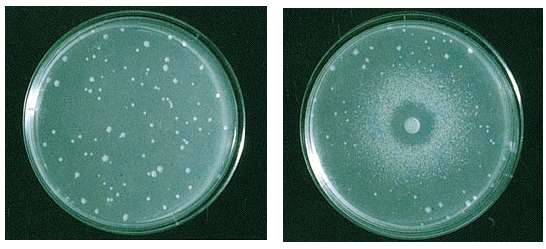
Reversion mutations
in the Ames Test
The dish on the left
was plated with about 109 his- bacteria.
In this control experiment, in the absence of the amino acid Histidine,
such bacteria will not grow, except for a small number (<102)
of white colonies derived from single bacteria that have undergone
spontaneous reversion mutations to his+.
In the experiment on the right, the filter-paper disc in the
middle of the dish contains a chemical being tested for mutagenic
properties. As it diffuses outward, the chemical first kills all
the bacteria (clear area around the disc), but at lower
concentration induces reversion
mutations in many 103s of revertant (
his+)
colonies. Note that as the concentration of the chemical drops off
towards the outer walls of the plate, the frequency of revertant
colonies falls to about the same as in the control.
The Ames Test
measures mutagenicity as the difference between the induced and spontaneous rates of
reversion mutation.

